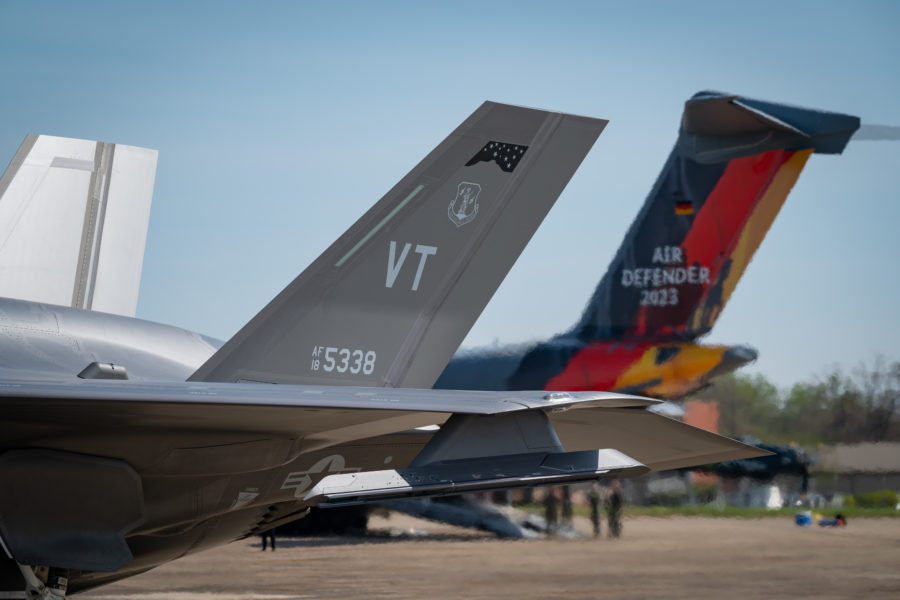JOINT BASE ANDREWS, Md.—U.S. and European allies will conduct a massive air exercise in Germany this June on a scale unseen since the end of the Cold War, military officials said.
Some 220 allied aircraft and 10,000 personnel will take part in Air Defender 23, against the backdrop of Russia’s invasion of Ukraine.
Around 100 U.S. aircraft, all from the Air National Guard, will come together with allied planes to practice combat, distributed operations, and degraded command and control. U.S. F-35s, F-16s, F-15s, A-10s, KC-135, KC-46s, C-130s, and C-17s will all take part, as well as hundreds of Airmen from 35 states.
The exercise will include mock enemy aircraft, known as Red Air, as allied “Blue” crews train how to fight with each other against a potential foe.
“Blue will be killing and Red will be killing,” ANG director Lt. Gen. Michael A. Loh told Air & Space Forces Magazine on April 5. “Everyone will see a little bit of Red.”
German-Led, NATO Heavy
Air Defender will mostly take place in Germany, but planes will also operate from forward operation locations in the Czech Republic, Estonia, and Latvia, and airbases across the continent will host participating aircraft.
A German military spokesperson stressed that the exercise was organized by Germany, not NATO headquarters, but it will include support from the alliance, and 22 of 24 participating countries are NATO members, along with prospective NATO member Sweden.
NATO has stepped up its air policing efforts in Eastern Europe since Russia’s February 2022 invasion of Ukraine. Many countries in the alliance, including Germany, have also pledged to strengthen their military posture, including their air forces.
“We have to take responsibility to stand up and say ‘OK, we are ready to defend the alliance,’” Chief of the German Air Force Lt. Gen. Ingo Gerhartz said.
Gerhartz, who has headed the Luftwaffe since 2018, was the driving force behind Air Defender, taking inspiration from the Defender series of large-scale ground exercises, said retired USAF Gen. Jeffrey L. Harrigian, who led U.S. Air Forces in Europe and NATO Allied Air Command from 2019-2022.
Gerhartz has also pushed to modernize the German air force, which will be boosted by a deal signed last year for 35 F-35 stealth fighters.
Harrigian said European allies saw a need to modernize their air forces even before Russia’s invasion. The dangers were highlighted at a 2019 NATO meeting in which the alliance deemed Russia a “threat” to security in the region, which enabled regional air forces to gain support for better equipment and training.
“That was a key political decision,” Harrigian told Air & Space Forces Magazine. “Because if we mass legitimate capabilities, it’s going to deter Russia, and they’re not going to want any part of what we could potentially do to them. And everybody got it.”
USAF Goals
While the idea for Air Defender is not wholly American, it will be a large-scale test of some of the U.S. Air Force’s new operating concepts, such as Agile Combat Employment—when Airmen and planes disperse in smaller teams to operate from remote or austere locations.
The six U.S. F-35s set to participate in the exercise are from the Vermont Air National Guard, which deployed to Europe last summer as part of NATO’s enhanced air policing mission.
The F-35 and its stealth technology are closely guarded secrets, which can make international operations more of a challenge. When two F-35s landed and parked in front of Loh and Gerhartz at Andrews recently, reporters were cautioned not to take pictures of the planes from certain angles.
“There’s too many people that can say ‘no,’” Loh said. But the ANG’s previous F-35 deployment “broke down those initial barriers,” he added.
Loh said he hopes Air Defender will have “more and more data sharing more and more people working on each other’s aircraft.”
Another skill the USAF plans to work on in Air Defender is the ability of aircrews to operate with some degree of autonomy—in contrast to the top-down campaigns the Air Force has conducted in the Middle East, with missions carefully coordinated by air operations centers in the region.
“It gets us out of what I would call the legacy mindset of CENTCOM,” Loh said.
Another closely related goal is encouraging quick thinking under fire.
“At some point, we’ve got to train before you can actually do it,” Loh said. “It doesn’t matter what it is, A-10, KC-135, are they going to be able to go ‘OK, I’ve lost our comms, everybody.’ I know what the initial plan was for today. Can I set myself up and do it as an aircraft commander, with a full crew, and take off and go make the next mission?”
Massive Scale
Though NATO and its members’ air forces have been increasing the number of air policing patrols and defensive drills, Air Defender will bring throngs of aircraft to bear in way that is not possible on a day-to-day basis.
“We need to exercise at this larger scale,” retired Gen. Phillip M. Breedlove, the former NATO Supreme Allied Commander, told Air & Space Forces Magazine. “We do not do it often enough.”
Gerhartz, whose nation will have around 60 aircraft participating and will provide logistical and command and control support, agrees.
“We have to be much more capable of defending the lines and it’s not just about talking or showing slides,” Gerhartz said. “We have to prove it, we have to demonstrate it.
“How do you inform Russia? Well, we won’t write them a letter. I think they get the message when we deploy.”

